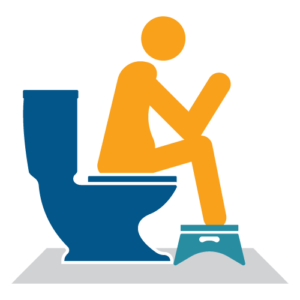
Using your belly and pelvic floor muscles to help bring about a bowel movement is instinctive for most people. However, people sometimes have problems with these muscles and must relearn proper emptying techniques. If you discover weaknesses in your muscles, continuously ignore and fight the urge to go to the bathroom, or consume a diet low in fiber and water, you may be straining to conduct a bowel movement. You may be doing this if you:
- Hold your breath or take in a gulp of air and hold it.
- Keep your lips and jaw tensed and closed tightly.
- Turn red in the face because of excessive pushing or forcing.
- Develop hemorrhoids or have existing hemorrhoids worsen.
- Get faint while pushing.
- Aren’t emptying, resulting in many trips to the restroom to feel complete.
Straining makes it harder to conduct a bowel movement. In some cases, the anus can tighten instead of relaxing and opening, resulting in difficulty getting stool out. Here’s how to sit on the toilet to relieve constipation.
EVACUATION PLAN: Conducted in 4 Basic Steps
When conducting a bowel movement, it is essential to position yourself appropriately.
- Lean forward enough for your elbows to rest on your knees. Keep your back straight and avoid slouching.
- Support your feet on the floor or use a low stool if your feet don’t touch the ground.
- Push out your belly as if you have swallowed a beach ball. You should feel a widening in your waist.
- Exhale and keep your stomach out.
Proper Bowel Elimination
Your healthcare practitioner may make the following additional suggestions and adjustments:
- Sit on the toilet.
- Make sure your feet are supported.
- Notice your hip angle and spine position – most people lean forward or raise their knees, which can help the muscles surrounding the anus to relax.
- when you lean forward, place your forearms on your thighs for support.
- With proper positioning, the pelvic floor muscles relax, and the bowel angle decreases, allowing ease of elimination.
- Relax.
- The digestive tract starts at the mouth and ends at the anal opening, so be sure to relax both ends of the tube.
- Breathe deeply in through your nose and out slowly through your mouth.
- Keep your pelvic floor muscles relaxed; let your belly bulge out.
- Empty.
- Inhale and stick your belly out as if you swallowed a beach ball.
- Exhale, keep your belly out and make it hard; this widens the anal opening.
- Complete.
- After completing your bowel movement, you can consider performing one or two pelvic floor muscle contractions.
Consider these steps when you sit on the toilet to relieve constipation. If you don’t feel any progress after conducting these steps, consult a health practitioner about the next steps in the process. Visit our Pelvic Health Page for more information about how physical therapy can help.
Written by Life Fitness Physical Therapy, with multiple locations throughout the Baltimore Area.




